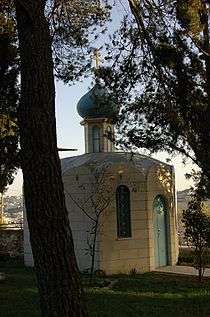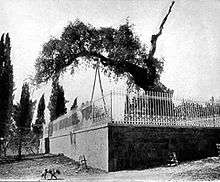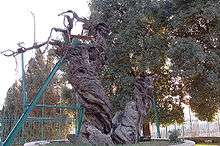Oak of Mamre

The Oak of Mamre (also called the Oak of Sibta), at Hirbet es-Sibte, two kilometres (1.2 miles) southwest of Mamre near Hebron.[1] Also called The Oak of Abraham[2] is an ancient tree which, in tradition, is said to mark the place where Abraham entertained the three angels[3] or where Abraham pitched his tent.
It is estimated that this oak is approximately 5,000 years old. The tree was venerated by Jews and Christians for hundreds of years, until Constantine in the fourth century stopped the practice by building a church there.
History



The site is mentioned by Arculf, a Frankish Bishop who toured the Levant in around 680. He writes:
A mile to the north of the Tombs that have been described above, is the very grassy and flowery hill of Mambre, looking towards Hebron, which lies to the south of it. This little mountain, which is called Mambre, has a level summit, at the north side of which a great stone church has been built, in the right side of which between the two walls of this great Basilica, the Oak of Mambre, wonderful to relate, stands rooted in the earth ; it is also called the oak of Abraham, because under it he once hospitably received the Angels. St. Hieronymus elsewhere relates, that this tree had existed from the beginning of the world to the reign of the Emperor Constantine ; but he did not say that it had utterly perished, perhaps because at that time, although the whole of that vast tree was not to be seen as it had been formerly, yet a spurious trunk still remained rooted in the ground, protected under the roof of the church, of the height of two men; from this wasted spurious trunk, which has been cut on all sides by axes, small chips are carried to the different provinces of the world, on account of the veneration and memory of that oak, under which, as has been mentioned above, that famous and notable visit of the Angels was granted to the patriarch Abraham. [4]
The site of the oak was acquired in 1868 by Archimandrite Antonin (Kapustin) for the Church of Russia, and the Monastery of the Holy Trinity was founded nearby.[5] The site has since been a major attraction for Russian pilgrims before the revolution, and is the only functioning Christian shrine in the Hebron region. After the Russian Revolution, the property came under the control of the ROCOR.
A long-standing tradition is that the Oak of Abraham will die before the appearance of the Antichrist. The main oak trunk has been dead since 1996.[6][7] In 1998 a root sprout appeared.[8]
Following construction work in the 1970s, a wooden ring in the form of a chalice was built around the tree, and its roots began to die. In 1997, a small sprig was seen growing near the withered oak. In October 2016, Russian botanists began a project to save the tree.[9]
References
- This article incorporates text from Oak of Mamre at OrthodoxWiki which is licensed under the CC-BY-SA and GFDL.
- ↑ Genesis 13:18 Then Abram removed his tent, and came and dwelt in the plain of Mamre, which is in Hebron, and built there an altar unto the LORD(KJV)
- ↑ The Hebrew term Eloney Mamreh of Genesis 13:18 is considered by some translators to be a name of a region in Canaan. Other scholars dispute this and suggest that it is the reference to the terebinth trees of Mamre; or to the Oak of Mamre, which is now known as Abraham's Oak
- ↑ New Challenge for Arafat: A Russian Church by Serge Schmemann for the New York Times, July 11, 1997.
- ↑ Arculf (1896). "The Pilgrimage of Arculfus in the Holy Land, page 33 -34". archive.org. The library of the Palestine Pilgrims' Text Society. pp. 33–34. Retrieved 2016-07-15.
- ↑ The Hebron Monastery has emerged as a political issue between Russia and Palestinian authorities.
- ↑ "Hebron's holy tree is dead but its successors live.". accessmylibrary.com. 27 December 1996.
- ↑ "Rome News-Tribune – Google News Archive Search". google.com.
- ↑ "Российские специалисты проанализировали состояние Мамврийского дуба". pravoslavie.ru.
- ↑ "Russian experts will work in Palestine to save the Oak of Mamre mentioned in Bible". Interfax. October 24, 2016.